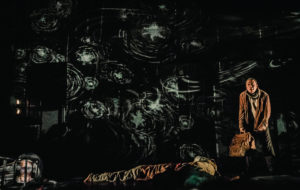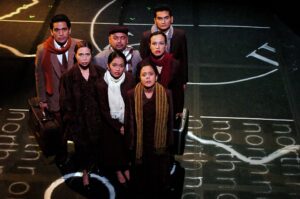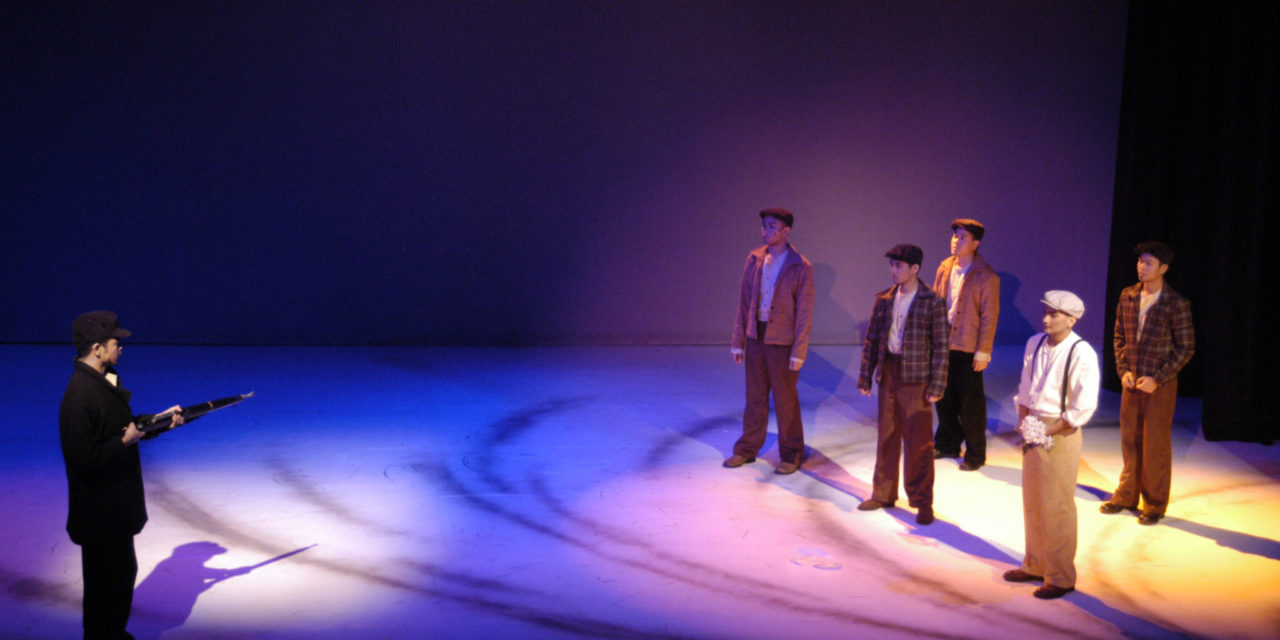Ariane Mnouchkine, the founding Artistic Director of Théâtre du Soleil in France, abhors the use of the word production to refer to a theater piece. In an interview with Andrew Dickson for the Guardian, Mnouchkine remarks, “I hate the word ‘production.’ It’s a ceremony, a ritual—you should go out of the theatre more human than when you went in.” Mnouchkine envisions the theater more as a religious ritual like the Eucharistic celebrations of the Catholic Church, where supposedly the individual solemnly reflects upon the teachings of the Gospel, in which every word is somehow indicative of how to live life to the fullest—morally and socially.
This understanding of theater is difficult to envision in a city like Manila, where theater is considered an alternative form of storytelling and an alternative mode of entertainment and spectacle. Storytelling is highly regarded as the primary concern of theater in the Philippines, unlike the storytelling experienced in melodrama shows on local television.
Nevertheless, I have experienced a theater in the Philippines which is in a way comparable to the ceremonial underpinnings of Mnouchkine. It is the theater of José Estrella. Since her return to the University of the Philippines (UP) Diliman in 2001 from a Fulbright Scholarship at Columbia University (MFA in Directing), her body of work has touched issues of war, migration, and transnational engagements.

Melvin Lee as Jean Genet in José’s staging of Bilanggo ng Pag-ibig (adaptation by Rody Vera based on the novel Prisoner of Love and other works of Jean Genet), 11 February to 1 March 2015, at the Wilfrido Ma. Guerrero Theatre (Photo: Adrian F. Begonia).
One of Estrella’s most recent theater works is an adaptation of Jean Genet’s novel Prisoner of Love, billed as Bilanggo ng Pag-ibig (text by Rody Vera, 2014). Estrella entangles the novel with Genet’s life and his other works and hints at the present Palestinian experiences in the Gaza Strip. In this theater piece, Estrella is not interested in a retelling of Genet’s biography. She takes inspiration from Genet’s life and works, which she then uses to present striking visuals that capture terrifying images of the naturalization of the stranger as vile and as mischief. More particularly, Estrella shows how the Palestinians (at least in the eyes of Genet) are treated as mischiefs and troublemakers. This is how the stranger or the outsider such as a migrant or a refugee is treated in another land outside the territory of his or her own nation. There is a double displacement: displacement from his or her homeland and displacement from being treated as a human community. This poetic theater piece, in the end, left me pondering how a larger community is responsible for the persecution and oppression of those who are “not-like-us.” Overall, Bilanggo ng Pag-ibig initiated a conversation about the strangeness of the stranger (e.g., the outsider, the migrant, the foreigner). One may not agree with the boldness of Estrella’s politics of the stranger, but hers is a starting point for the re-evaluation of how racism and other forms of discrimination may begin in one’s own backyard.

The cast of Sepharad: Voces de Exilo (counterclockwise: Neil Ryan Sese, Mailes Kanapi, Sigrid Bernardo, Dolly de Leon, Che Santos, Lex Marcos, and Richard de Guzman) (Photo: Dulaang UP).
In 2004, Estrella devised a theater piece based on and inspired by Sepharad: Voces de Exilo, a novel of the same title by Antonio Molina that deals with the Holocaust experience of the Hispanic Jews during Nazism. Estrella adapted Molina’s novel with some insertions of parallel Filipino experiences of displacements. She opened the play with a scene of a group of Filipino migrant workers in Madrid celebrating being Filipinos through food sharing and nostalgic storytelling about the homeland. This strategy, in my mind, is her way of dissecting connections between the Philippines and Spain. She seems to suggest that violence can be caused by transnational engagements where the migrant is treated like a stranger—the outsider who should not be trusted. This, in a way, underscores her critique of the deterministic popular concept of territorial nationalism (for example, the Nazis justified their actions by proclaiming they were just following the orders of their national government).
Estrella’s works also question and critique what it means for an individual to be a member of a community. Her vision of community does not revolve around territorial artifice. In staging the unfinished work of Federico Garcia Lorca, El Maleficio de la Mariposa, in 2003, Estrella presented two protagonists—a beetle and a wounded butterfly. Considered a threat to the beetle community, the butterfly is held hostage by the community elders. However, one beetle falls in love with the wounded butterfly. Transgressing community norms, the beetle boy helps her recover. When the butterfly is awakened, the beetle community begins attacking her. The butterfly, together with the beetle, dies. Estrella’s final image of this unfinished piece is the resurrection of the two insects: both flying away and leaving the beetles’ territorial community.
In 2002, Estrella staged Ramon Valle de Inclan’s Divinas Palabras. In this modern tragedy on adultery, José presented hypocrisy masquerading as religious fanaticism. In the original text, the adulteress Maria Gailo is stripped, spat upon, and mocked by her community. Poised to throw a stone, Pedro, Maria Gailo’s husband, pronounces the divine words “let him who has no sin cast the first stone.” His pronouncement causes the people to disperse. In Estrella’s staging, the community is not persuaded after the proclamation of the divine words. The people continue to throw stones at the adulteress.
In 2003, José staged what may be deemed the first nondramatic theater piece in the metropolis (or maybe even in the entire country), Recoged Esta Voz. This show was based on and inspired by the life of Miguel Hernandez, a Spanish poet imprisoned as an enemy of the state during the Spanish Civil War in the latter part of the 1930s. The staging conflicted the arts community in Manila. During the gala night, some theater conservatives walked out and claimed that Estrella’s play was not “theater” but an extravagant poetry reading. Estrella’s staging was not a retelling of Hernandez’s life as expected by some audience members (including myself). The piece was a montage of images—choreographic images of the actors, the poetry of Hernandez, shadow puppetry, and video installations. The stage was bare, except for white drapes and other surreal shadows. Overall, there was no fictive world.
Although it is too early to talk about Estrella’s development as a director, I am convinced that Estrella’s works may be categorized into thematic phases—from her early works in UP Diliman, epic intercultural attempts such as her localization of Macbeth into Makbet (set in a Cordilleran village) in 1999, transnational and cross-cultural poetics, and cosmopolitan aesthetics. Nonetheless, one theme is common to all: there are moments in the history of humanity when the human person encounters and embraces what the philosopher Hannah Arendt calls radical evil. In these moments, one realizes that hell on earth is real because of the loss of communal bonds and intimacy. Thus, the theater of José Estrella enables her audience to encounter this hell on earth to show humanity’s inhuman character. It is this affective experience that compels individuals to act, to move, to be ethical—to experience the stranger as someone like us.
José Estrella’s theater persuades audiences to ask themselves how much of instrumentality reduces their encounter with the stranger for self-gratifying reasons—for one’s enjoyment and pleasure. Her theater would like to cleanse the encounter with the stranger by recuperating the human in humanity. Estrella’s theater reminds her audiences that violence has envisioned the stranger as the mischief—as not equivalent to the self but an object to instrumentalize, to use, and to even own. In her works, she provides a testament that engagement in war, for example, is also brought by fear, insecurity, and aggression in the face of the stranger. This premise is present in her take on Troyanas (an adaptation of Euripides’ The Trojan Women), staged at the Little Theater of the Cultural Center of the Philippines in 2005. Thus, war can reduce the stranger to an object, and it forgets the human in humanity.
This year, José Estrella is preparing for her ceremonial production of Goethe’s Faust, to be staged on the occasion of the National Arts Month of the Philippines, in February 2017. Estrella’s contemporary and Filipino adaptation of this German classic will for sure take us on a journey of the unfamiliar, especially since Faust is trying to reap the essence of life. I really do not know what to expect from this forthcoming production, since Estrella is still in the process of developing the Goethean text into something very contemporary. But one thing is for sure: Estrella has been calling for responsibility and care for the stranger—the other. On a final note, her moral discourse in her theater implies that moral experience is rooted in the epiphany of the encounter with the stranger—discovery of the other as another human person, not as an object of one’s enjoyment, work, or possession.
This post was written by the author in their personal capacity.The opinions expressed in this article are the author’s own and do not reflect the view of The Theatre Times, their staff or collaborators.
This post was written by Sir Anril Pineda Tiatco.
The views expressed here belong to the author and do not necessarily reflect our views and opinions.


















